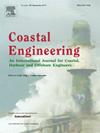Probabilistic storm surge and flood-inundation modeling of the Texas gulf coast using super-fast INundation of CoastS (SFINCS)
IF 4.5
2区 工程技术
Q1 ENGINEERING, CIVIL
引用次数: 0
Abstract
Accurately predicting flood extent and depths, encompassing storm surge, pluvial, and fluvial flooding, is important for protecting coastal communities. However, high computational demands associated with detailed probabilistic models highlight the need for simplified models to enable rapid forecasting. In this study we developed an ensemble-based probabilistic forecast framework using a reduced-complexity, hydrodynamic solver – the Super-Fast INundation of CoastS (SFINCS) model. The framework was showcased over Hurricane Ike that significantly impacted the Texas Gulf Coast in 2008. Results demonstrate the capability of the SFINCS model to generate probabilistic predictions (e.g., ≤4 h for a 100-member ensemble on a single multi-core CPU). The model agrees well with observed data from NOAA tidal, USGS stream gage height, and FEMA high water mark stations. Compared to a deterministic approach, the ensemble method reduced errors by an average 16% across all water level and hydrograph stations. Sensitivity analysis indicated consistent patterns of flood inundation across varying ensemble sizes (81, 189, 1,000) and lead times (1–3 days before landfall), with a slight increase in uncertainty for smaller ensembles and longer lead times. In particular, counties adjacent to the Trinity River Basin had ≥80% probability of exceeding the critical 3-m flooding depth during Hurricane Ike. Our study highlights the effectiveness of the SFINCS-based ensemble framework in providing probabilistic flood extent/depth forecasts over long lead times in a timely manner. Thus, the framework constitutes a valuable tool for effective flood preparedness and response planning during flooding events.
基于海岸超快速淹没(SFINCS)的德州墨西哥湾岸区风暴潮和洪水淹没概率模拟
准确预测洪水的范围和深度,包括风暴潮、雨洪和河流洪水,对保护沿海社区很重要。然而,与详细概率模型相关的高计算需求突出了简化模型以实现快速预测的必要性。在这项研究中,我们开发了一个基于集合的概率预测框架,使用降低复杂性的水动力求解器-海岸超快速淹没(SFINCS)模型。该框架在2008年飓风“艾克”对德克萨斯州墨西哥湾沿岸造成严重影响时得到展示。结果证明了SFINCS模型生成概率预测的能力(例如,在单个多核CPU上对100个成员的集成进行≤4小时的预测)。该模型与NOAA潮汐、USGS流计高度和FEMA高水位站的观测数据吻合良好。与确定性方法相比,集合方法在所有水位和水文站中平均减少了16%的误差。敏感性分析表明,不同集合规模(81、189、1000)和提前期(登陆前1-3天)的洪水淹没模式是一致的,较小的集合和较长的提前期的不确定性略有增加。特别是,在飓风艾克期间,三一河流域附近的县超过临界3米洪水深度的概率≥80%。我们的研究强调了基于sfincs的集成框架在提供长提前期的洪水范围/深度概率预测方面的有效性。因此,该框架构成了在洪水事件期间进行有效的洪水准备和响应规划的宝贵工具。
本文章由计算机程序翻译,如有差异,请以英文原文为准。
求助全文
约1分钟内获得全文
求助全文
来源期刊

Coastal Engineering
工程技术-工程:大洋
CiteScore
9.20
自引率
13.60%
发文量
0
审稿时长
3.5 months
期刊介绍:
Coastal Engineering is an international medium for coastal engineers and scientists. Combining practical applications with modern technological and scientific approaches, such as mathematical and numerical modelling, laboratory and field observations and experiments, it publishes fundamental studies as well as case studies on the following aspects of coastal, harbour and offshore engineering: waves, currents and sediment transport; coastal, estuarine and offshore morphology; technical and functional design of coastal and harbour structures; morphological and environmental impact of coastal, harbour and offshore structures.
 求助内容:
求助内容: 应助结果提醒方式:
应助结果提醒方式:


